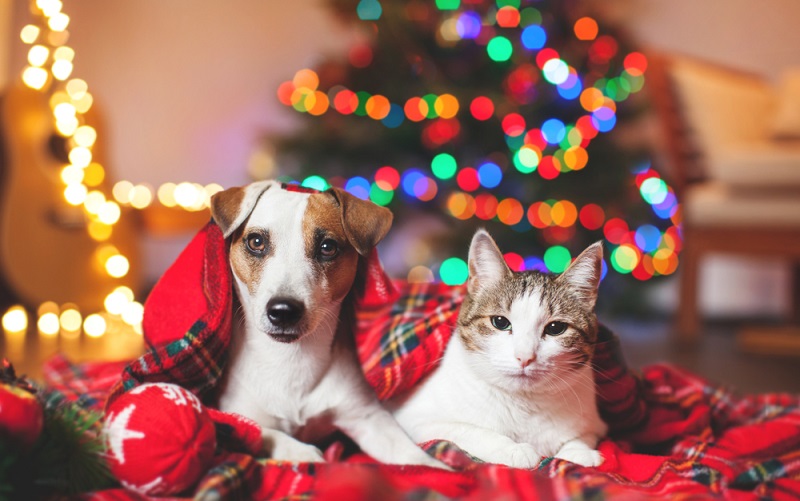12 Risks of Christmas – reducing threats to pets
We wish a happy holiday season for you, your family and your pets. With so much going on, it is easy to forget the risks that this time of year poses to our furry companions. Although most of these risks are throughout the year, we definitely see peaks at this time of year, likely due to the abundance of tasty treats and their accessibility.
Chocolate
With households often full of chocolate (and food containing it) throughout the Christmas period, it is important to keep these out of reach of pets. Even if it is wrapped and under a tree, dogs can sniff them out and will gladly help themselves. Chocolate contains the stimulant theobromine which can cause seizures and heart rhythm abnormalities.
Christmas pudding, cake and mince pies
Raisins, sultanas and grapes are key ingredients to many favourite Christmas treats and these can also be deadly if eaten by dogs. Sultanas, raisins, and grapes can cause acute kidney injury, which can lead to kidney failure, if eaten by our four legged friends. As well as Christmas puddings, fruitcakes and mince pies, panettones and trifles are a Christmas-time canine risk.
Nuts
With nut consumption peaking at Christmas times, there are associated risks for pets. The nuts and shells can be a choking hazard and can also cause intestinal problems. Macadamia nuts present an additional risk to dogs as ingestion has been associated with vomiting and weakness.
Bones
Bones from meat, poultry or fish present a dangerous threat to pets. Cooked bones are brittle and therefore can splinter when chewed. This can lead to the digestive tract being pierced or an obstruction. As well as not feeding scraps with cooked bones in, ensure pets do not tear open bin bags or scavenge bones from bins.
Sweeteners
Sugar substitute sweeteners are not only used in tea and coffee but also in many tasty treats, such as cakes, biscuits, mints, jam and peanut butter. Most are non-toxic to pets but xylitol is one that is commonly used which can be life-threatening to dogs. Affected dogs present with low blood sugar (hypoglycaemia) and this can loss of coordination, collapse and seizures within half an hour of consumption. Liver failure can follow.
Onion (including gravy)
Onions and products containing onions, such as gravy and stuffing, can cause gastrointestinal upset and lead to red blood cell damage and anaemia in cats and dogs. The related vegetables leeks, garlic and spring onions can also have the same effects.
Rock salt (grit)
The substance used to de-ice roads and pavements commonly called grit contains sodium chloride (salt), which can be hazardous to pets. If dogs and cats get it on their paws or fur their inclination will be to lick or chew it off, but this poses a risk. Ingestion of salt by pets can result in a high blood sodium concentration and this can lead to vomiting, lethargy, convulsions and kidney damage. If your pet has been walking on grit, then it is a good idea to wipe their feet and clean any exposed fur (such as on their legs or tummy). Dogs might also consume it by drinking puddles of melted snow.
Tinsel and ribbons
Given the chance, cats and kittens will play with ribbons used to wrap presents. These can be swallowed and become entangled in the cat’s intestines, causing life-threatening blockages. Playing with tinsel can cause the same problems in cats and other animals, including ferrets.
Christmas trees, baubles and fairy lights
Many cats and kittens will feel compelled to climb Christmas trees, endangering themselves. It is advisable to ensure trees are securely based so that they are less likely to be felled by a curious cat. Limiting access to rooms containing a tree when unsupervised is a good idea. Pet ingestion of pine needles can cause stomach upsets and intestinal problems.
Baubles are of particular fascination to cats. Glass baubles can shatter, creating sharp shards dangerous to animals and children. Dogs have been known to chew baubles and other decorations. This can lead to lacerations in the mouth or intestinal blockages.
Fairy lights pose the possibility of pets getting tangled up in wires, which can cause an animal to panic and injure themselves. If swallowed, bulbs can pose threats to pets.
Edible decorations are always going to be of interest to pets, and even placing them out of their eye-line won’t stop them from investigating further.

Other plants
Some plants brought into the house at Christmas, including holly, ivy and mistletoe, can be toxic to pets and lead to vomiting. If you do have them around the house it is best to keep them out of reach.
Toys
A dog might take an interest in a toy long after a child has discarded it. Small parts can be swallowed and cause intestinal blockages and larger toys may be chewed up and lead to the same problem, as well as mouth lacerations. Keep an eye on where children leave new toys and put them out of reach from pets. Puppies and younger dogs are far more prone to eat first and ask questions later, even if it is not food.
Batteries
With lots of new toys and gadgets around, there are likely to be more batteries around the home than normally. If chewed and swallowed they can cause an obstruction, chemical burns and heavy metal poisoning. Even small coin-shaped disc batteries are a threat to dogs as they can damage the oesophagus.

